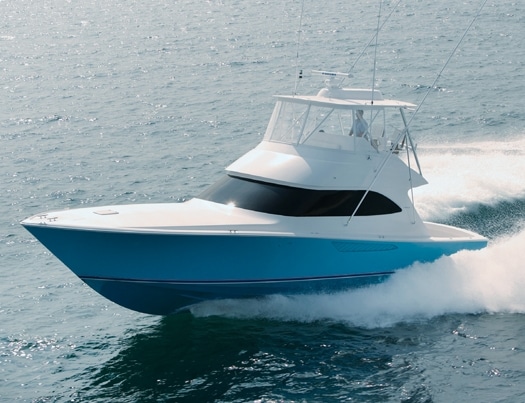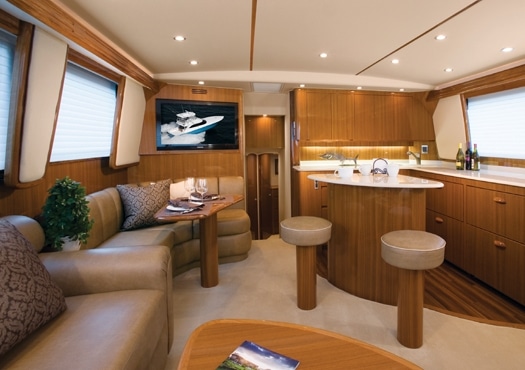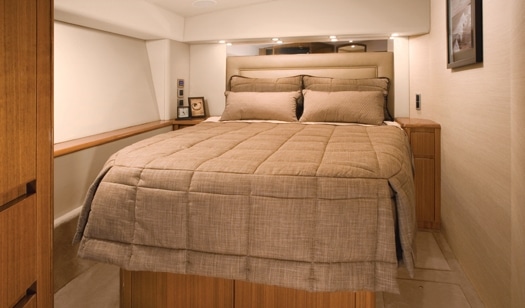
ytgjul09viking46525.jpg
Viking Yachts has earned a large piece of the production convertible market building boats with performance and features that were once available only from custom builders. As the serious anglers that invested in these boats ventured farther from the dock in pursuit of the bite, boats grew in size, complication, and capability. Bigger is better when covering long distances, but in terms of fishing, too big can be a handicap when wiggling around a fish. There is a sweet spot in my mind for those who want the best of both worlds and Viking’s new 46 Convertible is spot on.
The new 46 Convertible replaces a 45-foot model introduced in 2003. A new hull form with moderate propeller pockets and 12 degrees of deadrise serves as the platform for updated interior details and styling that reflect the builder’s latest thinking. While some convertible builders have wandered from tradition, Viking has embraced it and the 46 looks like a sportfisherman should. The position of her house is a result of the length required for her cockpit and sight lines from the helm determined the cut of her bridge. Her soft S-sheer links the tasteful rake of her stem to the soft corners of her transom. Sweeping house and bridge-face radii add to the length visually. A traditionally sculpted toe rail borders the foredeck and while a bow rail is standard, tournament types can opt out in favor of a cleaner look. While popular, this is a serious compromise as without the rail there is no way to move forward safely at sea. In tournament fashion, ground tackle is stored beneath a flush foredeck hatch. Here again I favor practicality and would gladly accept the standard pulpit.
Viking keeps an ear on the tournament docks and the 46 is targeted at serious anglers. Her cockpit accommodates a full-size fighting chair and has two large in-sole fishboxes. Our test boat had one plumbed as a live well. An ice machine feed is also possible. Viking has managed to incorporate a cockpit mezzanine on the 46-a popular feature on larger boats. There is tackle stowage, as well as a freezer beneath the seating, and a drink box in the cabin step can be refrigerated. To keep cockpit clutter to a minimum, gaff stowage is cleverly hidden in a compartment that extends forward beneath the gunwale and quick disconnects are provided for freshwater washdown. Our test boat was trimmed for fishing with a half tower, a fiberglass hardtop, and Rupp outriggers. Her hull was bathed in a brilliant Bahama Blue finish.
The 46’s flying bridge has tournament-grade Murray Products helm and companion seating facing a helm pod available in molded fiberglass or teak. Electronics bays have clear flip-up lids. Our test boat’s engine instruments were positioned overhead on the underside of the hardtop. While this works well, I would prefer a helm console location since it’s easier on the neck. A fore-and-aft settee adjacent to the helm is fitted with a backrest that can be positioned for a cockpit spotter or a sunseeking mate. Stowage space within is suitable for cleaning gear. Ahead of the helm, a forward-facing settee has internal storage as well and an adjacent drink box can be refrigerated. Hidden fasteners are used to secure the molded helm console and seating which reduces the chance of leaks and lends to the clean, custom look.

| | |
In terms of design, fit, and finish, the 46’s interior is a scaled-down version of Viking’s larger offerings. Viking has mastered the use of a processed teak veneer that yields a consistent, high-quality result. High-gloss and satin finishes are offered. I would suggest satin as it requires less care. Air conditioning registers and indirect lighting are thoughtfully hidden behind the valances. An L-shaped settee has a lift-top that allows easy access to the tackle stowage within. The galley is fitted with under-counter drawer- style refrigeration. There is an island bar with two stools as well as an L-shaped dinette. While it might be possible to shoehorn a three-stateroom arrangement into the 46, I favor Viking’s choice of a two-stateroom layout with a large master and private head. A guest stateroom has upper and lower berths and private access to the second head. If a third stateroom is a must, take a look at Viking’s 50-foot model.
The 46’s machinery space is accessible from the cockpit and its high-gloss finish and systems detail is well above standard fare in the production boat market. Our test boat was well endowed with a pair of 1,100-horsepower MANs-a $67,000 option. Access around the engines was good and auxiliary equipment appeared to be organized by folks that understand service. I also noted a number of features that have trickled down from Viking’s larger boats. The emergency de-watering system is an example-it is plumbed via a bypass from the engine’s raw-water intakes. Linear exhaust/ mufflers are fitted to optimize space beneath the cockpit and exit the transom custom-style through oval ports that are faired into the hull.
We conducted our sea trials aboard the 46 in mixed two- to four-foot seas offshore of Palm Beach, Florida. While eight-cylinder, 900-horsepower MAN diesels are standard, I suspect most will opt for our test boat’s 10-cylinder, 1,100-horsepower engines. I recorded a maximum speed of 38.4 knots and a fast cruise of just over 35 knots at 2100 rpm. For those moving up, the 46’s speed and precision, power-assisted steering will impress. For those used to running bigger boats, her power and ability to maneuver around the dock or on a fish will stimulate the senses. While she may not be as long-legged as her larger sisters, Viking predicts that her 870 gallons of fuel will allow her to run more than 350 nautical miles at 30 knots.

| | |
To appreciate just how far upscale the fishboat market has wandered, consider that in 1981 a 46-footer was the largest convertible Viking offered, while the new 46 is currently the smallest in its line. The 46 however is in no way an “entry level” boat-a boatbuilder’s standards become habit, and Viking’s focus has been on the high side for some time. What’s more, in terms of fishing, her size and maneuverability are a competitive asset. Tournament ready, our test boat tipped the scale at $1,479,249. Yes there is a price to pay for tournament-level quality and performance but the 46 is worth it!
Viking Yachts, (609) 296-6000; **www.vikingyachts.com**









